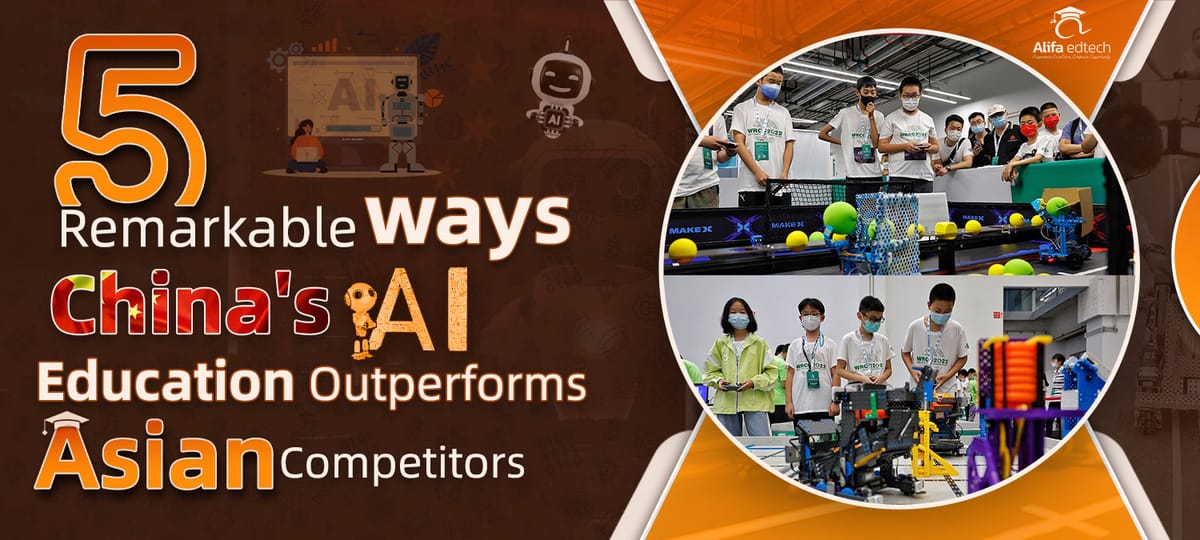AI Personalized Learning in China is using new and innovative solutions to make K-12 education better for every student. With the application of artificial intelligence technology, lessons change to fit each child’s needs.
This way, students build critical thinking skills, creative thinking, and higher-order thinking skills. AI helps children learn in a way that is fun and easy to understand.
Chinese schools use smart tools that guide students step by step. AI personalized learning in China is growing fast, and many students enjoy how it makes learning feel just right for them.
Why Are China's Schools Using AI to Help Students Learn Better?
China's schools now use artificial intelligence. AI creates personalized learning for students. Machine learning makes lessons bright and fun. These systems help every student learn better.
Alifa Education Services bridges ed-tech entrepreneurs and policymakers with China's leading AI companies. Get matched with the perfect technology partner for your region.
Book Your Partnership Consultation Today!
Tell us your needs—we'll find your ideal Chinese AI firm match.
Policies Are Opening New Doors for Smarter Learning
China has a "Double Reduction" policy. This policy is changing how students learn. Less homework and fewer private classes mean more free time.
Schools now focus on fun and useful skills. Learning is becoming smarter and more balanced. This gives every student a better chance to grow and enjoy education.
Parents and Students Want More AI in Education
Families want learning that fits each child. Each child has different learning styles. Mobile apps now reach 185 million people each month. These apps use big data to help students.
Kids like AI tools that match their learning path. Parents want less test stress for their children. They prefer personalized learning that keeps children happy. Educational data mining makes this possible.
Big Companies Are Shaping the Future of Smart Classrooms
TAL and New Oriental led the change in AI education. These companies work on AI literacy for students. They use natural language processing in their learning tools. Their tools support thinking and make learning fun.
Smart devices are now key parts of study time. These apps help students learn subjects better. The companies mix good content with new technology. This helps kids learn at school and at home.
AI Tools Are Growing Fast Inside and Outside Classrooms
AI tools are now everywhere in education. These tools work from classroom to home. They use data analysis to understand students. The devices adjust to how each student thinks. Apps guide kids through complex subjects using data mining.
These tools support each learner's needs. They offer interactive and fun learning experiences. Smart content improves education for all students.
Want to put your brand in front of families, students, and education-focused readers? We're inviting select partners to advertise with us on our trusted blog.
Want to get featured? Click 'Learn more' and submit a story for us to include.
More Investment Means Faster Innovation in AI Learning
Big money now goes into AI learning technology. Companies use this money to build AI content. They also make smart devices for students. These tools work for every type of student. Tech giants give support to these companies.
China's K-12 education system grows fast with learning analytics. These new resources bring better ways to teach. They work in schools, homes, and online platforms.
How China's K-12 Education Is Embracing AI for Personalized Learning
Chinese K-12 Schools use intelligent teaching systems. These systems create personalized learning environments for students.
Innovative Models Create Personalized Learning for Every Child
AI knows what each student needs. It gives AI-supported learning to help students. AI makes personalized learning content for each child.
This helps learning engagement get better. Students get what they need to learn. Generative AI makes learning fun. Students feel happy and excited in class.
Teaching Gets Better with Deep AI Integration
AI helps teachers do their job better. Teachers use AI for lesson planning and grading. Learning analytics tools help teachers focus on students.
AI tools make classroom work easier for teachers. Personalized learning programs help teachers teach better. Teaching becomes easier and more helpful for students.
AI Brings Learning to Every Corner of China
Many village schools need more help. AI-supported learning can help these schools. AI brings good understanding to all children.
Personalized learning spaces help every child learn. This brings AI literacy to all students. Ubiquitous learning helps China's schools get better. All students can learn well now.
Visual Display of How AI is Revolutionizing and Personalizing Learning in K-12 Schools.
Key Chinese AI Tools and Platforms Shaping AI Personalized Learning China
AI apps use artificial intelligence and generative AI to change China’s basic education. They adapt learning paths to fit each student’s learning characteristics and requirements.
Educational data mining gives teachers and parents real-time updates on progress. Chatbots in education support language learning and keep students motivated. These apps help build creative, critical, and higher-order thinking skills.
They free teachers to focus on teaching and guide students better. AI apps show a new direction in education for all learners.
Here are the top AI tools and platforms shaping personalized learning in China K-12 education.
AI Chatbots and Virtual Assistants
- Homework help: Students get instant answers for assignments
- Language support: Chinese, math, and English questions answered quickly
- Study guidance: Personalized learning paths for individual students
- Subject assistance: All school subjects covered by the chatbot
- Information gathering: Fast research help for student projects
- Educational support: 24/7 learning assistance for students
- Learning support: Homework explanations made simple and clear
- Subject explanations: Complex topics broken into easy parts
- Study companion: Always available for student questions
Smart Classroom Technologies
Smart Interactive Boards
- Touch control: Students interact directly with digital content
- AI integration: Smart features adapt to student needs
- Visual learning: Complex ideas shown through interactive displays
- Digital solutions: Complete classroom technology systems provided
- Interactive projectors: Learning becomes hands-on and engaging
- Smart connectivity: All devices work together seamlessly
Opportunities and Challenges in Scaling AI Personalized Learning in China
AI systems change how students learn today in China’s K-12 education. These systems use better tools and create new classroom experiences. Students get better learning results. Smart Education of China uses these new education technology tools worldwide.
Opportunities in AI Personalized Learning
- More Innovative Personalized Learning Experiences for Every Learner
AI builds personalized learning spaces for each student. These systems fit individual learning needs better. They help to learn to work faster and easier. Students get AI tools that match their learning speed.
Thus, the K-12 education model becomes more fun for students. This creates better learning results in different schools. Smart Education of China uses these tools well.
- Lifelong Learning Made Simple with Digital Platforms
AI systems help people learn throughout their lives. The Intelligent Operations Center supports all learners with personalized help. Students can learn problem-solving skills anytime they want.
This keeps students interested and happy about learning. Education technology makes learning easier for everyone. AI general education helps students stay motivated to learn more.
- Adaptive Assessments for Better Educational Outcomes
AI testing tools give fast and personalized results to students. These systems change questions based on how students perform. This helps students learn better, and teachers teach better.
Data analysis makes feedback easy to understand for students. AI adds value to schools by creating innovative ways. These tools help test student knowledge well.
- Admissions Reforms Using Generative AI
Generative AI tools change how Chinese schools choose students. These tools review applications fairly without unfair choices. Parents and teachers can stay involved in the process.
This change supports good choices and brings honesty. The K-12 education model builds trust across student success. Smart Education of China supports these reforms for better education.
- Increased Role of Instructors Through Smart Collaboration
AI changes how teachers work in classrooms today. Teachers use AI tools to focus on talking with students. This allows more teamwork in education, technology, and learning.
Teachers now support thinking and creativity instead of repeating lessons. The Intelligent Operations Center drives better teamwork between technology and teaching. This makes teachers important for good results.
Challenges in AI Personalized Learning China
- Ethical and Technical Challenges in AI-driven Systems
AI brings problems that need careful thinking and solutions.
Who controls student information and personal data? Can digital tools make unfair choices for students?
These are fundamental questions teachers ask about education technology. Technical problems like bugs and data gaps affect learning results. AI general education needs care with privacy and trust issues.
- Lack of Human Interaction in AI-powered Classrooms
AI helps efficiency, but too much use reduces human talk. Students still need guidance and emotional support from real people. Personalized learning systems cannot replace human relationships and care.
Teachers remain important in balancing digital learning with face-to-face support. The education model needs both AI and human interaction. Data analysis shows students need both types of support.
- Mismatch Between AI Tools and Real Learning Needs
Not every AI system works for every classroom situation. Student interest drops if tools do not match learning needs. Poorly designed systems can limit student growth and progress.
For AI to help students, there must be a good connection. The Intelligent Operations Center must match technology with real student needs. Smart Education of China works to fix these problems.
What's Next: The Future of AI Personalized Learning in Chinese Schools
AI grows fast in Chinese schools today. It changes how students learn every day. Schools use AI tools to build smart learning spaces. These spaces fit each student's learning needs well.
Generative AI will work with school lessons soon. These tools will check what students know first. Then, they change lessons to match each student. This makes learning fun and easy for everyone. It helps students learn faster and get better results.
Teachers will use data to help students learn. Deep learning gives teachers real-time feedback about student progress. Students will enjoy learning more than before. Lifelong learning will become stronger for all students.
China's digital learning tools will reach more schools. But there are some technical problems and ethical problems. Not all AI tools work perfectly for students. Teachers still have important jobs to do. Teachers need to guide and support all kids.
AI in education will help international students, too. It will build teamwork in education around the world. AI will help international students succeed in school.
The future will not teach everyone the same. AI will help each student grow in their own way.
Conclusion
AI Personalized Learning China is changing the educational process by applying artificial intelligence technology. It brings intelligence to language education and makes basic education smarter.
Chatbots in education support students by understanding their behavioral patterns and giving suitable learning choices. This new way of learning is part of educational reform that aims to grow innovative talent. AI brings intelligence to education that fits each student’s needs.
Even though there are some challenges, AI makes learning easier and more fun. AI Personalized Learning China is opening doors to a better future for all students in China.
Related Articles
















Member comments